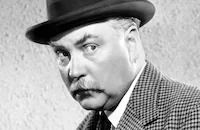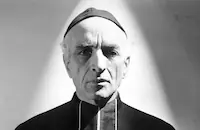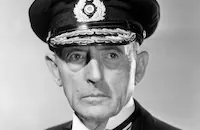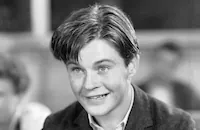Under Two Flags
Brief Synopsis
Cast & Crew
Frank Lloyd
Ronald Colman
Claudette Colbert
Victor Mclaglen
Rosalind Russell
Gregory Ratoff
Film Details
Technical Specs

Synopsis
At the turn of the century in southern Algeria, a French Algerian cafe hostess named Cigarette, whom British Major L. C. Doyle wants to marry, flirts with Corporal Victor, who saved his convoy from an attack by the rebel chieftain Sidi-Ben Youssiff, but Victor ignores her. After Victor is promoted to sergeant, he sees Cigarette try to swindle a British officer in a horse deal and wagers a bottle of wine to a kiss that he can beat Cigarette racing. After he wins, Victor further antagonizes Cigarette by offering his horse for her to kiss. She then rides into the desert, he follows, they kiss and she confesses her love for him. Victor meets Lady Venetia Cunningham, the niece of the British commissioner, and after showing her the Arab village, he invites her late at night to a nearby oasis. Although she initially refuses, she arrives later and spends the night with him, while Cigarette, greatly upset, waits up all night. After chieftain Ben Hamidou, who sides with the British, is murdered by chieftains loyal to Sidi-Ben Youssiff, war is declared. Before the troops leave, Victor learns that Lady Venetia is the niece of the visiting Lord Seraph. Worried that Lord Seraph will recognize the little wooden horse which Victor gave Lady Venetia, Victor sneaks into Lady Venetia's room to retrieve it. They confess their love for each other, but Victor reveals that he will be sent to prison if he returns to England. Meanwhile, Doyle, now a colonel, learns that Cigarette, who jealousy witnessed Victor and Lady Venetia's goodbye kiss, loves Victor. After the battalion leaves, Lord Seraph discovers the wooden horse and tells Lady Venetia that the horse was once given to him by Rafe Brett, a popular officer who disappeared after taking the blame for an accident committed by his younger brother, and who since has been cleared completely. Lady Venetia confronts Cigarette, and learning that Doyle has been sending Victor on extremely dangerous missions to get him killed, she asks Cigarette to save him. She refuses, knowing that Victor loves Lady Venetia. Meanwhile, Doyle, uncomfortable with his actions against Victor, orders his battalion to rescue Victor and his men. During a battle, Doyle is shot in the shoulder, and afterward, with the battalion surrounded, Victor tells him that he does not love Cigarette. After Victor meets with Sidi-Ben Youssiff to stall for time, Cigarette brings French troops to attack, and during the battle she is shot. As she dies in Victor's arms, he says he will always remember their day in the desert and kisses her. The revolt is prevented, and Cigarette is given an honored burial at the post.

Director
Frank Lloyd
Cast

Ronald Colman

Claudette Colbert

Victor Mclaglen

Rosalind Russell

Gregory Ratoff

Nigel Bruce

C. Henry Gordon

Herbert Mundin

John Carradine
Lumsden Hare

J. Edward Bromberg

Onslow Stevens

Fritz Leiber

Thomas Beck
William Ricciardi

Frank Reicher
Francis Mcdonald
Harry Semels
Nicholas Soussanin
Douglas Gerrard
Tor Johnson
Gwendolen Logan
George Regas
Hans Von Morhart
Jamiel Hasson
Jack Pennick
Gaston Glass
Frank Lackteen
Marc Lawrence
Rolfe Sedan
Eugene Borden
Harry Worth
Tony Merlo
Alex Palasthy
Jack Wagner
Maurice Brierre
Karl Hackett
Jean De Briac
Rosita Harlan
Jacques Vanaire

Fred Malatesta
George Jackson
Andre Cuyas
Juan Duval
Carl De Loro
Joe Sawoya

John George
Tofik Mickey
Hector Sarno
B. Martinez
Joe Dominguez
Dave Dunbar
Albert Pollet
Jack Gallagher
Al Thompson
Ray Jones
Rex Richards
George Ducount

William Mccormick
Stubby Kruger
Ralph Banks
Harry Dean
Coit Albertson
Gino Corrado
Jack Kenny
Earl "hap" Hogan
Mason Litson
Chauncey Pyle
Charles Drubin
Karma Faris
George Sowards
Spike Spackman
Dick Hunter
Frank Cordell
Johnnie Eckert
Julius Cesena
A. Massih
Robert Burns
Sergei Arabeloff
Ed Warren
Cliff Smith
H. Better
James C. Lowry
Louis Carmon
Scoop Martin
Charles Haefeli
Cecil Kellogg

Robert Walker
Theodore Schalin
W. Skiff
Mike Domit
Andrew Mckenna
Nick Shaid
S. Barbar
Jack Kirk
Archie Butler
Neal Hart
John Judd
Lee Powell
Frank Gusky
Joseph B. Kerrick
Lloyd Saunders
Frank Ellis
Vinegar Roan
Whitey Sovern
Bob Dyer
Joe Flores
Lieutenant George Blagoi
Richard Clark
Tyrone Brereton
Art Dupuis
Jim Thorpe
Bill Gillis
Charles B. Griffin
Bill Hurley
Larry Dodds
Bill Wilson
Dave Kashner
Pete Mckenna
A. Ghandour
George David
Sam Abed
Charlie Abraham
S. Nahas
N. Badran
Joseph Abed
Joseph Sabbah
Abdullah Abbas
Jim Hanah
Sam Aboud
Tom Abdo
E. Faysal
J. A. Reshaw
Antony E. Michael
A. F. Zauhire
K. Haggar
Ahmad Joseph
Abraham Mohamed
Kassin Alli
Mohamed Barada
Mahmood Alei
Fred Hakim
Nousa Ahmed
Peter Totah
Joe Rogers

Tommy Brown
Crew
Joseph Aiken
Dave Anderson
Don Anderson
Hilda Anderson
Clarence Baker
Joe Balch
Douglas Baxter
Lance Baxter
Frank Beetson
Jasper Blystone
Marie Brasselle
Otto Brower
Tony Carnagle
Slip Carruth
Eldo Chrysler
James B. Clark
Steve Clemente
D. L. Daniels
W. R. Daniels
William Darling
Glenn Delfino
Ralph Dietrich
Ed. Ebele
A. F. Erickson
Walter Ferris
Lee Frederic
Aline Goodwin
Charles Graham
Raymond Griffith
Ed Hammeras
Jamiel Hasson
Roger Heman
Sid Jordan
Harry Kernell
W. P. Lipscomb
Thomas Little
Robert Mack
Cliff Maupin
Booth Mccracken
Jack Mcedwards
V. L. Mcfadden
Bess Meredyth
Mickey Meyers
Sidney D. Mitchell
Paul Mohn
Phillip Moore
Ray Moore
William Murphy
Dick Narr
Pluma Noisom
Red O'hara
Al Orenbach
Jack Padjan
Ernest Palmer
Jack Percy
Lew Pollack
Allen Rivkin
Harry Roberts
Buddy Roosevelt
Kent Sanderson
Ad Schaumer
Joseph M. Schenck
Fred Sersen
Rog Sherman
Louis Silvers
Ben Silvey
George Starkey
Carl Stecker
Otto Steiger
Joe Thompson
Sidney Wagner
Gwen Wakeling
Jack Wells
Darryl F. Zanuck

Film Details
Technical Specs

Articles
Marc Lawrence (1910-2005)
Born Max Goldsmith on February 17, 1910, in the Bronx, Lawrence had his heart set on a career in drama right out of high school. He enrolled at City College of New York to study theatre, and in 1930, he worked under famed stage actress Eva Le Gallienne. Anxious for a career in movies, Lawrence moved to Hollywood in 1932 and found work immediately as a contract player with Warner Bros. (an ideal studio for the actor since they specialized in crime dramas). He was cast as a heavy in his first film, If I Had a Million (1932). Although his first few parts were uncredited, Lawrence's roles grew more prominent: a sinister henchman in the Paul Muni vehicle in Dr. Socrates (1935); a conniving convict aiding Pat O'Brien in San Quentin (1937); a menacing thug stalking Dorothy Lamour in Johnny Apollo (1940); the shrewdly observant chauffeur in Alan Ladd's breakthrough hit This Gun For Hire (1942); and one of his most memorable roles as Ziggy, a fedora wearing mobster in the Bogart-Bacall noir classic Key Largo (1948).
Lawrence, when given the opportunity, could play against type: as the prosecuting attorney challenging Tyrone Power in Brigham Young (1940); a noble aristocrat in the Greer Garson-Walter Pidgeon period opus Blossoms in the Dust; and most impressively, as a deaf mute simpleton in the rustic drama The Shepherd of the Hills (both 1941). Better still was Lawrence's skill at comedy, where his deadpan toughness worked terrifically as a straight man against the likes of Joe E. Brown in Beware Spooks (1939); Abbott and Costello in Hit the Ice (1943); Penny Singleton in Life with Blondie (1945); and Bob Hope in My Favorite Spy (1951).
After that, Lawrence's career took a turn downward spin when he was labeled a communist sympathizer during the Hollywood witch hunts of the early '50s. He was exiled in Europe for a spell (1951-59), and when he came back, the film industry turned a blind eye to him, but television overcompensated for that. Here he played effective villains (what else?) in a series of crime caper programs: Peter Gunn, Johnny Staccato, The Untouchables, Richard Diamond, Private Detective; and eventually made a welcome return to the big screen as a returning exiled gangster in William Asher's underrated mob thriller Johnny Cool (1963).
It wasn't long before Lawrence found himself back in the fray playing in some big box-office hits over the next two decades: Diamonds Are Forever (1971), The Man with the Golden Gun (1974), Marathon Man (1976), Foul Play (1978); and The Big Easy (1987). Sure he was cast as a gangster, but nobody could play a rough and tumble mob boss with more style or conviction.
Interestingly, one of his finest performances in recent years was in television, as a severely ill old man unwilling to accept his fate in a fourth season episode of ER (1997-98). His last screen role was just two years ago, as a nimble minded VP in Looney Tunes: Back in Action (2003).
In 1991, Lawrence published a memoir about his venerable career, Long Time No See: Confessions of a Hollywood Gangster that received much critical acclaim. He has also developed a cult following due to his appearances in such offbeat items as From Dusk to Dawn and Pigs aka Daddy's Deadly Darling, the 1972 horror film he directed and starred in with his daughter Toni. He is survived by his wife, Alicia; two children from a previous marriage, Toni and Michael; and a stepdaughter Marina.
by Michael T. Toole

Marc Lawrence (1910-2005)
Quotes
Trivia
Simone Simon was to make her American screen debut in this movie in the role of 'Cigarette', but director 'Lloyd, Frank' demanded she be fired after two weeks of shooting because of her temperamental attitude. When she was replaced by Claudette Colbert, all Simon's footage was discarded. Knife thrower Steve Clemente was supposed to hit the post next to Ronald Colman with his knife, but the crowding caused it to be deflected and Colman was hit by the handle in the chest.
Notes
The novel originally appeared in the summer of 1867 in New London, a British military magazine, before it was published in book form in December 1867. Since 1870, a number of plays have been produced that were based on the novel. The Twentieth Century-Fox Records of the Legal Department at the UCLA Theater Arts Library contains a statement noting that the most important dramatization had been written by Paul Potter and originally produced in New York on January 21, 1901 and that a play by Edward Elsner had also been produced. The legal department cautioned the producers of the film that care should be taken to avoid the use of any material in previous copyrighted dramatizations. According to a Hollywood Reporter news item dated April 1, 1935, Universal Pictures, which, at that time, owned the motion picture rights to the play, was preparing to make the film. Fox, before they merged with Twentieth Century Pictures, then purchased the motion picture rights to the novel from Universal for $25,000 in May 1935, according to the legal records. Winfield R. Sheehan, at the time Fox's vice-president in charge of production, planned to produce the film. Sheehan subsequently left the company shortly after they merged with Twentieth Century.
Twentieth Century-Fox planned to have Simone Simon make her American screen debut in the role of "Cigarette," according to a New York Times article. Earlier, she had been scheduled to debut in A Message to Garcia, but had been replaced by Rita Cansino (later known as Rita Hayworth), who subsequently herself was replaced by Barbara Stanwyck. According to New York Times, after two weeks of shooting in the studio on this film, director Frank Lloyd, unhappy with Simon's temperamental attitude and wary of what might happen with her during location shooting in the desert, demanded that she be fired. The studio acceded to his wishes, the footage shot with her was scrapped, and after Claudette Colbert was hired to replace her at a substantially higher salary, press reports were sent out stating that Simon was leaving the picture because of illness, according to New York Times. According to the legal records, the insurance company Lloyd's of London paid the studio $115,000 for a release from all claims due to the illness of Simon, delays or additional expenses incurred in substituting Colbert.
According to a news item, a ten-acre Arabian desert village was built on the Twentieth Century-Fox Westwood lot, and the battle sequences were filmed in the California-Arizona desert eighteen miles from Yuma using Hollywood extras, local cowpunchers and Yuma Indians. News items noted that the company planned to spend forty-two days shooting at Palm Springs, CA and Yuma. According to the legal records, some shooting also took place at Palm Canyon, CA. According to a Hollywood Reporter news item, at the end of 1935, the unit at Palm Springs split into four parts briefly: Frank Lloyd directed Ronald Colman and Victor McLaglen at Palm Canyon; Ad Schaumer directed Simone Simon at Indio; Ben Silvey directed a third unit; and Jasper Blystone directed process shots at La Quinta. A New York Times news item called the production "the most expensive location trip to emerge from Hollywood in ten years." New York Times estimated that the cost of the film, which was budgeted at $1,250,000, would probably rise to $1,500,000 before its completion. Otto Brower, who directed the battle scenes in the desert, was known for having earlier directed serials. According to news items, the desert set was near the site where Beau Geste, produced in 1926 by Famous Players-Lasky (see AFI Catalog of Feature Films, 1921-30; F2.0307), was filmed, and that Selznick International's The Garden of Allah, filmed later in 1936, was filmed at the same location. A Daily Variety news item noted that 212 war veterans were signed to play a Foreign Legion regiment.
According to publicity for the film, during one scene in which Steve Clemente, a Yaqui Indian professional knife-thrower, was supposed to hit a post next to Ronald Colman, the crowding in of extras caused the knife to be deflected, and Colman was hit in the chest with the handle. In her autobiography, Rosalind Russell states that she did not meet Colbert during the production; however, in the film, she can be seen in shots together with Colbert. News items from June and July 1935 stated that Warner Baxter, Bill Robinson, Slim Summerville and Edward Everett Horton were to be in the film, but they ultimately were not involved in the production. According to a New York Times news item, both John Ford and Frank Lloyd were outraged that Darryl Zanuck cut their films, The Prisoner of Shark Island and this one, respectively, and declared that they would never go to the Twentieth Century-Fox lot again. While Ford subsequently did direct for Twentieth Century-Fox, Lloyd did not. Other films based on the same source include the 1916 Fox Film Corp. production directed by J. Gordon Edwards and starring Theda Bara, and the 1922 film produced by Universal, directed by Tod Browning and starring Priscilla Dean (see AFI Catalog of Feature Films, 1911-20; F1.4648 and AFI Catalog of Feature Films, 1921-30; F2.5949).














